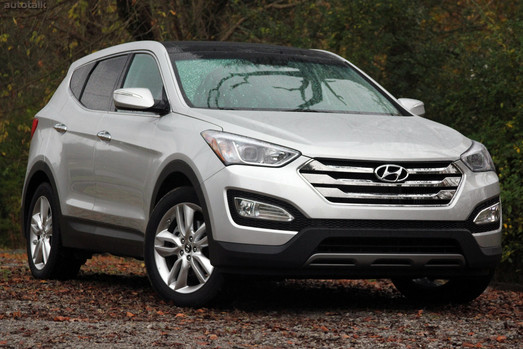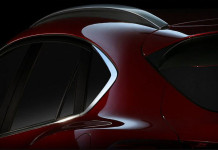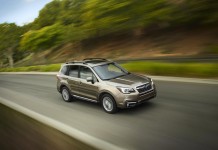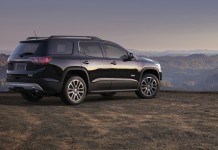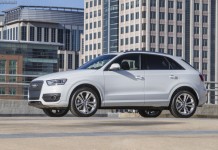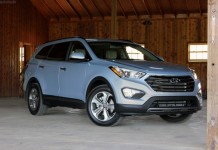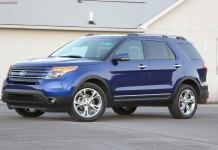Hyundai has been on a roll over the last few years, with new models that are surpassing the expectations of the market, and the competitors in that market are getting surpassed in many ways too. With the introduction of the new 2013 Santa Fe at the New York Auto Show this year, Hyundai is aiming square at the CUV Market currently dominated by the likes of the Chevy Equinox, Toyota RAV4 and others. Does this newest take on the mid-size CUV market make a splash, or is Hyundai’s newest effort dead in the water? We took the 2013 Hyundai Santa Fe Sport for a week to find out what the thing was made of.
The first thing everyone notices about the new Santa Fe is that it actually looks good. Hyundai has been rapidly improving its design portfolio, and the old Santa Fe had the face of a troll, so there was nowhere to go but up. The chiseled jaw line and sharp body creases do much to define the overall style of the Santa Fe, while the tapering top helps the vehicle look smaller than it really is. Thoughtful touches like the LEDs in the headlamps and the small rear spoiler provide some sporting flair.
Inside Hyundai has made many more dramatic improvements. The interior has a sharp design with angled edges everywhere and lots of cool textures. A large portion of the dash is covered in a flexy rubber that features a very fine tiger stripe pattern that is very grippy. You could actually rest a device like a cell phone on the surface with little worry of it slipping. The dash top is still made of plastic, but it is a very solid and high enough that you will likely ever touch it. The door panels have padded leather at the armrests and an upper portion of the same rubber as the dash. Our tester had a metal look paint finish that covered much of the door panel and control switches that looked nice, but we are unsure of how it will wear. The seats of the new Santa Fe were very supportive and comfortable with soft black perforated leather. Rear passenger seats were also comfortable with plentiful amounts of leg and shoulder room. Rear seat passengers are also treated to seat heaters.
The interior of our tester was loaded with every option like the Infinity stereo and 8-inch touchscreen, but by far the greatest asset of the interior is the massive panoramic sunroof. The sheer amount of glass on the roof is beyond impressive and it stretches nearly the entire length and width of the Santa Fe. Every person we put inside the crossover was impressed with the view skyward.
Our tester’s 12-speaker stereo sounds impressive on paper, but in practice is less than advertised. The system does produce decent sound at lower levels, but at higher volumes much of the clarity is lost. The system seems to muddy, almost as if the mid-range gets boosted with volume. The navigation unit, however, is a pleasure to use. The system’s large screen makes quick glances a breeze, and the software is quick to respond and very accurate with its directions. One of the fanciest pieces of technology is Hyundai’s keyless entry system. The system operates like any other and features a push-button starter, but the quality and design of the key fob itself, sets the Santa Fe apart. The key features a unique design with leather and chrome touches that looks much more elegant than the chunk of plastic offered by competitors like Nissan.
Making all that glass, technology, and leather move down is Hyundai’s 2.0-liter turbo engine and six-speed automatic transmission. The turbo four is good for 264 horsepower and Hyundai says that despite the power the Santa Fe will return 27 mpg on the highway. While this engine is praised in other application through the Hyundai line, we find that the drivetrain is the weakest link in the Santa Fe’s chain.
The problem comes from power delivery. The little turbo is a fairly high-strung engine that delivers its power in a huge lump. This can be tons of fun in a sporting sedan, but less so in a large crossover. The transmission programming doesn’t help matters either. When attempting to accelerate the Santa Fe will drop gears instantly providing immense power output and flinging the CUV forward with much more force than anticipated. This is not only mildly alarming to passengers, but during even the lightest rain it caused the traction control to have a massive seizure. To make matters worse, the fuel-sipping programming of the transmission makes the Santa Fe dump to the highest gear possible as soon as you think about letting off the throttle. The end result is a ride that is jerky, unpredictable and at times uncomfortable.
The main argument for going with the turbo four over a V6 is fuel economy savings, remember the Santa Fe is claimed to 24 mpg on the highway. We managed just under that number by driving almost entirely on highway cruising, and actually did better than many of our colleagues have managed. Those are not very impressive numbers, and we are unsure how much of an MPG hit a V6 would make. We think the more linear response of a naturally aspirated V6 would suit the Santa Fe better, with any fuel economy hit being well worth the refinement and predictability. To top it off, a V6 would remove complexity and cost from the vehicle.
The drivetrain follies are made worse by the steering. Hyundai has fitted the Santa Fe with an adjustable steering system that is designed to provide multiple levels of steering assistance, but only succeeds in disconnecting the driver. You turn the wheel and the car turns, but there is ZERO sensation that the steering wheel is actually attached to the front wheels by any physical means.

Hyundai has made massive strides in three to four years that many other makers took decades to perform, and what they have built is admirable, but the pursuit of fuel economy has harmed the Santa Fe dearly. If you really want a good crossover, wait for the V6 equipped seven-passenger Santa Fe to arrive later this year. The meaty midrange and progressive power build of a naturally aspirated engine will do wonders for this otherwise great machine.

